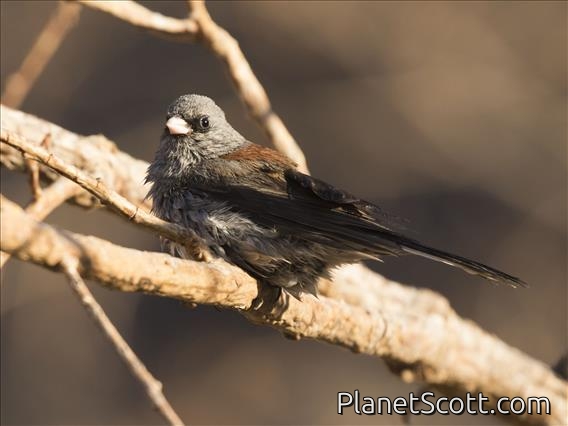Dark-eyed Junco (Junco hyemalis)

Dark-eyed Junco (Junco hyemalis) - Gray-headed
×


Dark-eyed Junco (Junco hyemalis) - Gray-headed
About Dark-eyed Junco (Junco hyemalis)
- Kingdom: Animals
- Phylum: Chordates
- Class: Birds
- Order: Perching Birds
- Family: Old World Buntings
The dark-eyed junco is a species of junco, a group of small, grayish New World sparrows. The species is common across much of temperate North America and in summer it ranges far into the Arctic. It is a variable species, much like the related fox sparrow, and its systematics are still not completely resolved.
Source: Wikipedia
Trips
Visits
-
2006-05-15
Glen Canyon Park, United States of America -
2006-08-06
Angel Island, United States of America -
2007-01-01
Golden Gate Park - Lily Pond, United States of America -
2007-04-10
Cuyamaca State Park, United States of America -
2008-05-28
Glen Canyon Park, United States of America -
2008-09-20
Emigrant Wilderness, United States of America -
2008-11-17
Skylawn Cemetary, United States of America -
-
2009-04-04
Bernal Hill, United States of America -
2009-06-10
Glen Canyon Park, United States of America -
2009-11-07
Pinnacles National Monument, United States of America -
2010-05-29
Potter Marsh, United States of America -
2010-06-08
Talkeetna, United States of America -
2010-06-08
Denali State Park, United States of America -
2010-06-11
Petersburg - Wrangell Narrows, United States of America -
2010-11-20
Elgin - Bluff Spring Fen, United States of AmericaSlate-colored. There were a couple of flocks of 20+ here. -
2011-05-28
Del Valle County Park, United States of America -
2012-07-12
Yellowstone National Park, United States of America -
2012-07-13
Grand Teton National Park, United States of America -
2012-09-30
Golden Gate Park - Stow Lake, United States of America -
2012-10-08
Presidio - El Polin Spring, United States of America -
2012-12-06
Solano County Farmlands, United States of America -
2013-03-04
John Heinz NWR at Tinicum (IBA), United States of America -
2013-03-07
Spring Valley Nature Sanctuary, United States of America -
2013-05-06
Mount Davidson, United States of America -
2013-05-12
Redwood Valley, United States of America -
2013-06-05
Lake Tabeaud, United States of America -
2013-06-06
Middle Fork Cosumnes River, United States of America -
2013-07-02
Yolla Bolla Wilderness, United States of America -
2013-08-25
Ventana Wilderness, United States of America -
2013-08-31
Mountain Lake, United States of America -
2013-09-28
Presidio - El Polin Spring, United States of America -
2013-10-05
Corona Heights, United States of America -
2014-02-16
Golden Gate Park - San Francisco Botanical Garden, United States of America -
2014-02-16
Golden Gate Park - North Lake, United States of America -
2014-03-10
San Simeon SP, United States of America -
2014-03-22
Baker Beach, United States of America -
2014-04-06
Delta Meadows State Park, United States of America -
2014-04-26
Bernal Hill, United States of America -
2014-05-03
Glen Canyon Park, United States of America -
2014-06-01
Bayview Park, United States of America -
2014-06-07
Sunol Regional Wilderness--Visitor Center area, United States of America -
2014-06-15
Golden Gate Park - North Lake, United States of America -
2014-07-12
Windy Hill OSP, United States of America -
2014-09-14
Buena Vista Park, United States of America -
2014-09-23
Redwood Valley, United States of America -
2014-10-02
Golden Gate Park - San Francisco Botanical Garden, United States of America -
2014-12-08
Golden Gate Park - San Francisco Botanical Garden, United States of America -
2015-01-03
Woodward Park, United States of America -
2015-01-04
Del Puerto Canyon and Mines Road, United States of America -
2015-01-17
Lafayette Park, United States of America -
2015-01-18
Tilden Regional Park, United States of America -
-
-
-
-
-
-
-
-
-
-
-
-
-
-
-
-
-
2018-04-23
Big Bend National Park, United States of America -
-
-
-
-
-
-
-
-
-
-
-
-
-
-
-
-
-
-
-
-
-
-
-
-
-
-
-
-
-
-
-
-
-
-
-
-
-
-
-
-
-
-
-
-
-
-
-
-
-
-
-
-
2025-09-18
Charleston Road Marsh, United States of America







